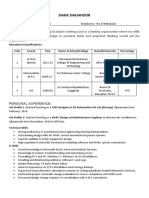0% found this document useful (0 votes)
91 views23 pagesIntro to Propositional Logic
1) The document introduces propositional logic and its importance for reasoning about computer programs and arguments.
2) Propositional logic uses declarative sentences that can be true or false, and symbols like ¬, ∧, →, and ↔ to represent logical connectives like negation, conjunction, implication, and bi-implication.
3) Arguments can be abstracted and represented logically using variables and connectives, removing specifics to focus on logical form.
Uploaded by
HadiCopyright
© © All Rights Reserved
We take content rights seriously. If you suspect this is your content, claim it here.
Available Formats
Download as PDF, TXT or read online on Scribd
0% found this document useful (0 votes)
91 views23 pagesIntro to Propositional Logic
1) The document introduces propositional logic and its importance for reasoning about computer programs and arguments.
2) Propositional logic uses declarative sentences that can be true or false, and symbols like ¬, ∧, →, and ↔ to represent logical connectives like negation, conjunction, implication, and bi-implication.
3) Arguments can be abstracted and represented logically using variables and connectives, removing specifics to focus on logical form.
Uploaded by
HadiCopyright
© © All Rights Reserved
We take content rights seriously. If you suspect this is your content, claim it here.
Available Formats
Download as PDF, TXT or read online on Scribd
/ 23





























